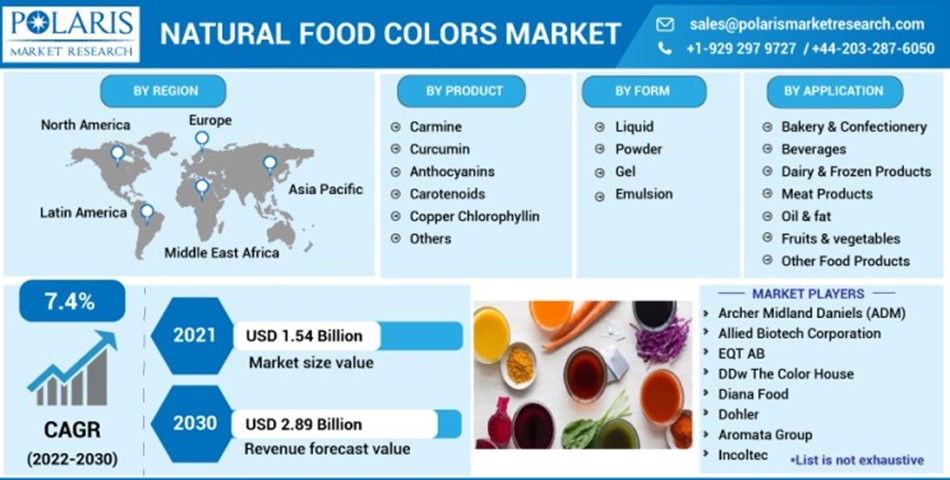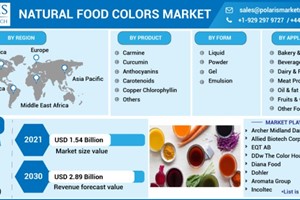According to a recent market report released by Indian market research company Meticulous Research, the natural food coloring market will reach US$3.2 billion by 2027, with a compound annual growth rate of 8.4% during the forecast period (2019-2027).
Amongst many, Spirulina is a new hot spot
By type, the natural food coloring market is mainly subdivided into Anthocyanins, Caramel, carmine, Carotenoids, Chlorophyll, Spirulina, Turmeric and Beets. Carmine accounted for the largest share of the entire natural food coloring market in 2019, mainly due to its growing demand in the food and beverage industry. This is due to the wide application of this unique red color in many foods, such as cake frosting, Hard candies, baked goods, ice cream, yogurt, gelatin desserts, fruit syrups and jams/preserves. However, the spirulina natural food coloring market segment is expected to achieve the fastest compound annual growth rate from 2019 to 2027, mainly due to the strong health and wellness trends, as well as the beverage and confectionery industry’s natural blue and green coloring Demand continues to grow.
During the forecast period, animal-derived food coloring will grow the fastest
By source, the natural food coloring market is divided into plant, mineral, microbial and animal sources. Plant-derived food colorings account for the largest share of the entire natural food coloring market in 2019, mainly due to the increasing demand for organic food coloring from various parts of plants. However, by 2027, the animal-derived food coloring market segment is expected to grow at the highest compound annual growth rate, as the application of animal-derived food coloring in various foods, beverages, and halal certified packaged foods increases.
Liquid form is mainstream
By form, the entire natural food coloring market is divided into liquids, powders, gels, and emulsions. In 2019, liquid forms accounted for the largest share of the entire natural food coloring market, mainly due to the increasing demand for viscosity, taste, product stability, texture, shelf-life taste and appearance during the production of food and beverage products. In addition, food coloring in liquid form is expected to grow at the highest compound annual growth rate, mainly due to its high microbial stability.
Water-soluble pigments occupy the largest market
Divided by solubility, the entire natural food coloring market is mainly subdivided into water-soluble and oil soluble. In 2019, water-soluble pigments account for the largest share of the entire natural food coloring market, which can be attributed to the increasing demand for its application in food and beverage products, as well as the characteristics of high concentrated color, high-cost performance and stability in water.
Food coloring for beverages will grow fastest in the future
By application, the entire natural food coloring market is mainly subdivided into processed foods and beverages. In 2019, processed food applications accounted for the largest share of the entire natural food coloring market, which can be attributed to the growth of the processed food industry and the growing demand for natural food coloring. However, from 2019 to 2027, the beverage sector is expected to grow at the highest compound annual growth rate, mainly due to the increased demand for the use of natural food coloring to increase the energy-nutrient ratio in beverages. In addition, consumers' increasing awareness of the negative effects of artificial additives has further supported the demand for natural pigments for beverages.
Asia Pacific will usher in the fastest growth
The global natural food coloring market is divided into five main regions, namely North America, Europe, Asia Pacific, Latin America, and the Middle East and Africa. The European region accounted for the largest share of the global natural food coloring market in 2019, mainly due to the increased demand for natural and organic foods, increased investment in research and development, the emergence of many natural color suppliers in the region and increasing government support to promote food industry. However, during the forecast period, the Asia-Pacific region is expected to grow at the highest compound annual growth rate, mainly due to rising consumer preference for natural ingredients, increased consumer awareness of the negative effects of synthetic pigments, and consumer spending power Enhancement and strong growth in the catering industry. In addition, the government is increasingly tightening its regulations on restricting the use of synthetic pigments, which is expected to support the growth of the natural food Pigment market in the region.
Major market participants
The main players in the global natural food coloring market include Ke Hansen, DSM, Senxin Technology, ADM, Döhler Group, DDW, Naturex SA, Aromata Group, Kalsec Inc., FMC Corporation, BASF, Lycored Ltd., GNT Group bv, San-Ei Gen FFI, Inc., Phinix International, Kolorjet Chemicals Pvt. Ltd., Vinayak Ingredients India Pvt. Ltd., IFC Solutions and INCOLTEC.
Article Source:
ECHEMI - https://www.echemi.com/
Images courtesy of:
Polaris Market Research – www.polarismarketresearch.com
Food Research Lab - https://www.foodresearchlab.com/












